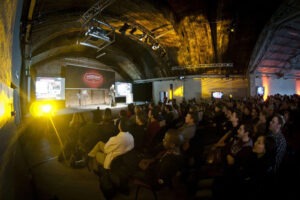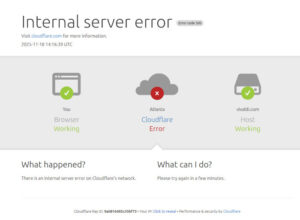Hook one of these BLE babies up with facial recognition technology and we’ll be living smack dab in the middle of a Philip K. Dick novel.

Roblimo’s Hideaway
Do you spend a lot of time thinking about Bluetooth Low Energy (BLE) beacons? Unless you run a retail store, probably not. But if you do run a store (or stores) along with an e-commerce operation, BLE is a hot new thing you are either using already or thinking about using before long.
Why? Because the graffiti is on the wall, and it says, “Sales in physical stores are going down every year, and most retailers aren’t seeing enough online sales gains to take up the slack.” BLE may help stop the retail sales slide or at least slow it down. It’s cheap enough, especially with open source beacons, that it’s certainly worth a try.
How a BLE proximity system works
The simplest use of BLE is to trigger a notice on a smartphone that comes near your store that says something like, “Hey, c’mon in and get a free gift!” Say you’re a fashion retailer with locations in shopping malls. Any time someone with your app installed on their phone comes near one of your stores, they get that message. Since they’re already your customer, which you know because they have downloaded your app, there’s a good chance they’ll come into your store.
The trick is, all the BLE device does is trigger a cellular or wi-fi connection with your company’s web servers, which display an appropriate page for that location, time of day, and even weather outlook. This keeps the BLE device tiny and cheap. Nordic Semiconductor, to mention one supplier among many, is getting ready to ship a javascript-programmable “Puck.js” device the size of a coin that runs for months on a watch battery. They say it’s easy to program and/or hack (it’s 100% open source) from a smartphone, and it doesn’t require any wiring or installation. Cost? Around $30.
I said this was one of many, and little BLE devices are proliferating like digital bunnies. Prices are dropping. It is already possible to put one set of beacons near your store’s entrance, and beacons in each department that trigger announcements that tell shoppers you have a new shipment of sportsball shoes for them to look at. Or if they go near your Fiddlethwap department, that Seguendish(tm) Thwaphonglers are 40% off — today only!
Sell, sell sell! That’s what retailing’s all about, right? And if you can get someone into the store to actually try on a piece of clothing, you have a fair chance of making a sale you might not have been able to make through your website — and that Amazon probably couldn’t make through their website, either.
Didn’t Apple already try something like this?
They sure did, back in the late Pleistocene year of 2013. “Location-aware services” was the buzzphrase Apple hoped would be on everybody’s lips in a New Jersey minute, but didn’t get much traction outside of Apple’s own stores.
Wait a minute. Did somebody say “proprietary?” Yes, the iBeacon setup was both proprietary and Apple-priced, so thin-margin retailers treated it as a trade show curiosity, not as something to actually use in their stores.
In 2015, Google came out with an open-source Bluetooth beacon protocol they called Eddystone after a famous lighthouse. I mentioned the Nordic Semiconductor initial (anticipated) beacon price of $30. You can get Eddystone beacons for around $10 with a little shopping. The Nordic ones are totally packaged; duct-tape them to the ceiling, whatever. Worth the extra? Probably for some. not for others.
Beacon software? There’s so much of it out there — talking open source, of course — that we might as well just link to this Q&A on Stack Overflow that lists a whole stack of BLE stuff.
And another detail: Apple’s iBeacon worked only with iOS, while Eddystone works with Android, of course, and with iOS, too.
BLE services are coming to an everywhere near you
Right now, most installed BLE beacon systems only work with a retailer’s phone app, but this is changing rapidly. Google is touting Nearby Notifications, which works with Android 4.4 or newer, and recent iOS releases, even without a special app on the customer’s phone. Indeed, one thing it can do is suggest that the customer download the store’s app, which (if the apps I tested while learning about BLE are any example) can also hook the customer up with the company’s online sales arm. Omnichannel retailing! Yes, it’s another buzzphrase, and one that’s becoming popular in the business world in 2017, since all retailers now seem to be selling across multiple channels, which is darn convenient even if all it means to many of us (like me) is ordering a door online from Home Depot so they have it at the front of the store when I go to get it.
(An aside: Walmart hasn’t figured out the front-of-the-store pickup thing yet. Unlike Home Depot — and BestBuy, Bed Bath & Beyond, and a lot of other omnichannel retailers — they make you go all the way to the back of the store to pick up online orders. Grrr….)
An opportunity for IT entrepreneurs
Making the beacon hardware is a job for Giant China Industries, and running a rack of BLEs doesn’t take much software you can’t find on GitHub or other open source software sites. But the units do have to be placed in the stores, they have to have the right greetings installed, and they need to be checked periodically and have their batteries replaced sooner or later.
If you are in (or would like to be in) the IT service business, this is work you may be able to get. Chances of you landing the Macy’s account are slim, but local and regional retailers? Still pretty much a wide-open market. Go for it!
Robin “Roblimo” Miller is a freelance writer and former editor-in-chief at Open Source Technology Group, the company that owned SourceForge, freshmeat, Linux.com, NewsForge, ThinkGeek and Slashdot, and until recently served as a video editor at Slashdot. Now he’s mostly retired, but still works part-time as an editorial consultant for Grid Dynamics, and (obviously) writes for FOSS Force.








?? The walmart I frequent has the pickup right at the front. In fact, the walmart is in a mall, and the pickup is effectively at the walmart/mall interface, with the entrance to the walmart actually across the entry hall from the pickup area.
I know as I bought a new home last year and have been ordering a lot of stuff from walmart.com ship-to-store, as I work and am not at home to accept delivery most days.
But I don’t have a cellphone yet. Too much closed source and “unlimited” data thru the 2G coffee stir-stick for the 29 days left after I use the pitiful monthly full-speed allowance in a day sounds anything BUT “unlimited” to me! Not worth it! But every few years I check again… maybe with 5G…
Reading Google’s description of “Nearby Notifications” it clearly isn’t a feature made for the benefit of Android users, but rather as a way to push ads at them:
https://developers.google.com/nearby/notifications/overview
No thanks. the last thing I want on my phone (or any computing device) is more ads.
I’m with Mike. I’ve managed to live pretty much without Ads, by not having a TV or a radio, by aggressively blocking adverts and scripting on my Browser, for quite a few years now, and I still find everything I need.
I even manage to be better informed than most of the people I meet who live daily with TV and Radio and lots and lots of ads.